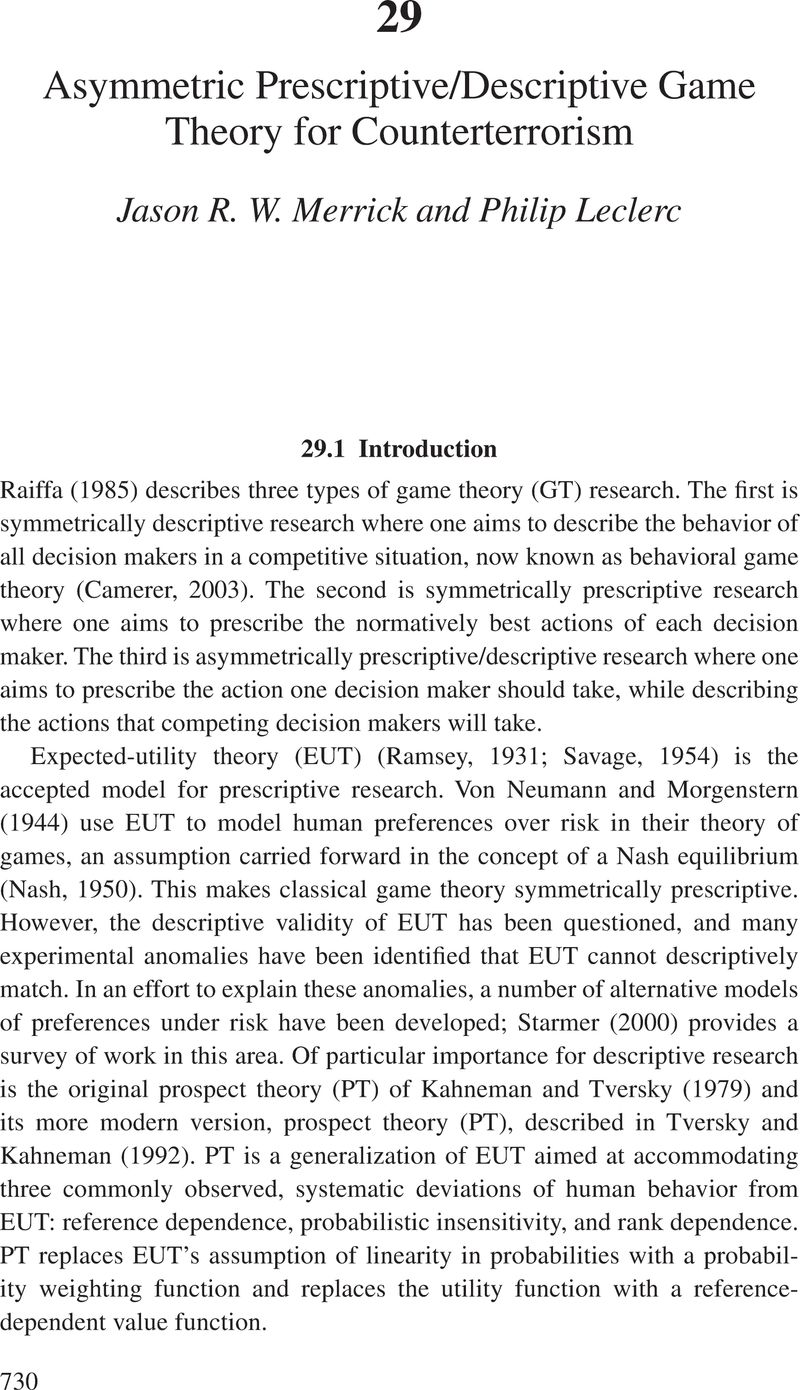Book contents
- Improving Homeland Security Decisions
- Improving Homeland Security Decisions
- Copyright page
- Contents
- Contributors
- 1 Improving Homeland Security Decisions
- 2 Probabilistic Risk Analysis and Terrorism Risk
- 3 Integrating Stakeholder Values into Strategic Planning through Comparative Risk Analysis
- 4 Validating Terrorism Risk Assessment Models – Lessons Learned from 11 Models
- 5 Coping with Uncertainty in Adversarial Risk Analysis
- 6 A Risk and Economic Analysis of Dirty Bomb Attacks on the Ports of Los Angeles and Long Beach
- 7 Regional Transportation and Supply Chain Modeling for Large-Scale Emergencies
- 8 Economic Consequences of Terrorism and Natural Disasters: The Computable General Equilibrium Approach
- 9 Economic Resilience to Terrorism and Natural Hazards
- 10 The Temporal Regional Economic Impacts of a Hurricane Disaster on Oil Refinery Operations: A FlexNIEMO Approach
- 11 Risk-Informed Benefit-Cost Analysis
- 12 Enhancing Post-disaster Economic Resilience: Public-Private Partnership for Insuring Terrorism
- 13 Economic Impacts of Changes in Wait Times at U.S. Ports of Entry
- 14 Organizational Decision Processes
- 15 A Value Model for Evaluating Homeland Security Decisions
- 16 Identifying, Structuring, and Comparing the Objectives of Al Qaeda and ISIL
- 17 Multi-objective Decision Making: Expected Utility vs. Some Widely Used (and Flawed) Methods
- 18 Achieving Multiple Objectives with Limited Resources: Using Utility Theory and Control Theory
- 19 Defender-Attacker Decision Tree Analysis to Combat Terrorism
- 20 Decision Making for Bioterror Preparedness: Examples from Smallpox Vaccination Policy
- 21 Stackelberg Security Games (SSG) Basics and Application Overview
- 22 Basic Solution Concepts and Algorithms for Stackelberg Security Games
- 23 Mixed-Integer Optimization Methods for Solving Stackelberg Security Games
- 24 Methods for Addressing the Unpredictable Real-World Element in Security
- 25 Learning to Play Stackelberg Security Games
- 26 Evaluating Deployed Decision Support Systems for Security: Challenges, Analysis, and Approaches
- 27 Homeland Security Resource Allocation Games: Considering Partially Strategic Attackers and Equity
- 28 Decision Analysis by Proxy for Adaptive Adversaries
- 29 Asymmetric Prescriptive/Descriptive Game Theory for Counterterrorism
- 30 Near-Misses and Decision Making Under Uncertainty in the Context of Cybersecurity
- Index
- References
29 - Asymmetric Prescriptive/Descriptive Game Theory for Counterterrorism
Published online by Cambridge University Press: 13 December 2017
- Improving Homeland Security Decisions
- Improving Homeland Security Decisions
- Copyright page
- Contents
- Contributors
- 1 Improving Homeland Security Decisions
- 2 Probabilistic Risk Analysis and Terrorism Risk
- 3 Integrating Stakeholder Values into Strategic Planning through Comparative Risk Analysis
- 4 Validating Terrorism Risk Assessment Models – Lessons Learned from 11 Models
- 5 Coping with Uncertainty in Adversarial Risk Analysis
- 6 A Risk and Economic Analysis of Dirty Bomb Attacks on the Ports of Los Angeles and Long Beach
- 7 Regional Transportation and Supply Chain Modeling for Large-Scale Emergencies
- 8 Economic Consequences of Terrorism and Natural Disasters: The Computable General Equilibrium Approach
- 9 Economic Resilience to Terrorism and Natural Hazards
- 10 The Temporal Regional Economic Impacts of a Hurricane Disaster on Oil Refinery Operations: A FlexNIEMO Approach
- 11 Risk-Informed Benefit-Cost Analysis
- 12 Enhancing Post-disaster Economic Resilience: Public-Private Partnership for Insuring Terrorism
- 13 Economic Impacts of Changes in Wait Times at U.S. Ports of Entry
- 14 Organizational Decision Processes
- 15 A Value Model for Evaluating Homeland Security Decisions
- 16 Identifying, Structuring, and Comparing the Objectives of Al Qaeda and ISIL
- 17 Multi-objective Decision Making: Expected Utility vs. Some Widely Used (and Flawed) Methods
- 18 Achieving Multiple Objectives with Limited Resources: Using Utility Theory and Control Theory
- 19 Defender-Attacker Decision Tree Analysis to Combat Terrorism
- 20 Decision Making for Bioterror Preparedness: Examples from Smallpox Vaccination Policy
- 21 Stackelberg Security Games (SSG) Basics and Application Overview
- 22 Basic Solution Concepts and Algorithms for Stackelberg Security Games
- 23 Mixed-Integer Optimization Methods for Solving Stackelberg Security Games
- 24 Methods for Addressing the Unpredictable Real-World Element in Security
- 25 Learning to Play Stackelberg Security Games
- 26 Evaluating Deployed Decision Support Systems for Security: Challenges, Analysis, and Approaches
- 27 Homeland Security Resource Allocation Games: Considering Partially Strategic Attackers and Equity
- 28 Decision Analysis by Proxy for Adaptive Adversaries
- 29 Asymmetric Prescriptive/Descriptive Game Theory for Counterterrorism
- 30 Near-Misses and Decision Making Under Uncertainty in the Context of Cybersecurity
- Index
- References
Summary

- Type
- Chapter
- Information
- Improving Homeland Security Decisions , pp. 730 - 744Publisher: Cambridge University PressPrint publication year: 2017

